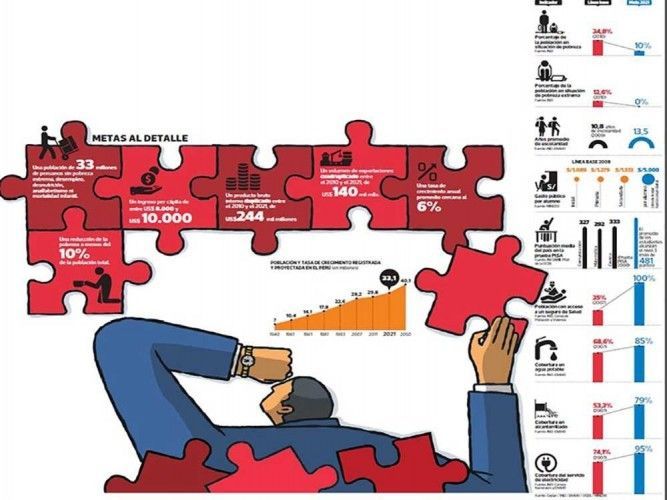During his first speech as Peruvian president four month ago, Pedro Pablo Kuczynski (PPK) announced that he “wants a social revolution for his country”. But the big questions is what actually includes a social revolution and how can it be achieved? The goals of the Peruvian government were drawn up in accordance with the “Plan Bicentenario” published by the National Strategy Planning Center (CEPLAN) in 2010. For the celebration of the country’s 200th anniversary as independent Republic of Peru in 2021, follwoing 6 main goals should be accomplished.
- A population, approx. 33 million citizens, without extreme poverty, unemployment, malnutrition, illiteracy and child mortality
- Reducing poverty to less than 10%
- A nominal per capita income between US$ 8000 and US$ 10,000
- Doubling the nominal GDP from 2010 to 2021
- Quadrupling the volume of exports from 2010 to 2021
- Achieving an annual growth rate close to 6%
Reforms in Peru are the key to reach set goals
To succeed Peru has to undertake serious, partly difficult reforms now in 3 sectors vital to the economy: infrastructure, health and education that are interdependent and partly overlap.
Conquer infrastructure challenges with public-private-partnerships
According to experts the most challenging sector is infrastructure. Peru needs public and private investments in this area to increase the 3% share in the GDP to 8%. The most feasible way to finance these necessary investments is to form public-private-partnerships, which today are often hampered and unnecessarily delayed by bureaucracy. So, a fierce political will is necessary to reform the legal framework and promote investment. The same applies to urgent projects such as the expansion of Jorge Chavez International Airport in Lima for example that is delayed due to land disputes. Experts warn that the goals for 2021 won’t be achieved, if significant changes aren’t made now.
Reform health sector on all levels
The health sector won’t be any less challenging. One big problem in the health sector is the financing. While in neighboring country Chile or even in Colombia 45% of the population contributes to the public health system, in Peru only 19% do so. A second challenge is the quantity and quality of Peru’s health care facilities that is far lower than the average in Latin America. As the plan is to give 100% of the Peruvian population access to health insurance and proper health care by 2021, the inactivity in this sector during the last 15 years has to stop. Local and international experts agree that drastic changes are necessary and the way to go are as well public-private-partnerships. Granting private investors to construct, manage and operate health care facilities and upgrade the medical equipment is as important as bringing more Peruvians into formal employment, so they can contribute to the health system, and improving the training of medical staff.
Improve education
This brings us to the education sector. While eradicating illiteracy might be a reachable goal by 2021, the overall desolate public education system needs changes and investments immediately. Not only is it necessary to invest in the education buildings that are especially in the provinces in bad shape and in the digital infrastructure, but as well in the training of teachers and their salaries. To improve the overall education – at the last PISA study Peru only ranked 121 from 138 participating countries - and to give Peruvians the opportunity for a better future money has to be spend here as well. Experts explain that a combination of public and private investments are indispensable to financially cope with the challenges ahead.
Anual Executive Conference (CADE 2016)
So, if we believe local and international experts, the answer to progress in Peru is the quite theoretical statement of public and private investments. How to achieve the countries goals from a more practical perspective, is discussed at the Anual Executive Conference (CADE 2016) held in Paracas from the 30th of November until the 2nd of December. The CADE is a forum in which representatives from the public sector and business organizations meet to openly discuss the key issues of the country and put forward proposals from the standpoint of the business community. This year 9 Peruvian ministers and the country’s most important entrepreneurs are among the attendees of the CADE with the motto “Challenge 2021 – The opportunity is now”. We have to wait and see what suggestions Peru’s business community can contribute.
Anyway, the next 5 years will show how much willpower, endurance and diplomacy the Peruvian president and government have, to achieve set goals that are so important for the further development of Peru.


